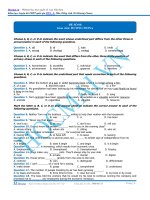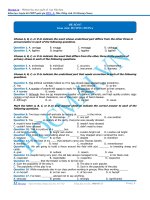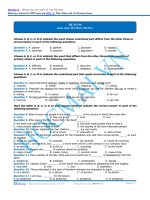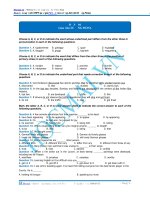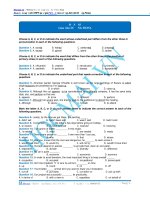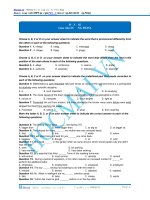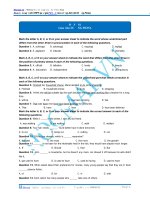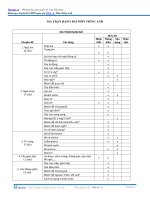- Trang chủ >>
- Đề thi >>
- THPT Quốc Gia
Tổng hợp 15 đề pen i n3 cô hương hocmai 2017 phần (5)
Bạn đang xem bản rút gọn của tài liệu. Xem và tải ngay bản đầy đủ của tài liệu tại đây (640.43 KB, 8 trang )
Hocmai.vn – Website học trực tuyến số 1 tại Việt Nam
Khóa học Luyện thi THPT quốc gia PEN - I: Môn Tiếng Anh (Cô Hương Fiona)
ĐỀ SỐ 05
Gíao viên: HƯƠNG FIONA
Choose A, B, C, or D to indicate the word whose underlined part differs from the other three in
pronunciation in each of the following questions.
Question 1. A. assault
Question 2. A. through
B. possession
B. enough
C. aggressive
C. rough
D. tasteless
D. tough
Choose A, B, C, or D to indicate the word that differs from the other three in the position of
primary stress in each of the following questions.
Question 3. A. appear
Question 4. A. government
B. version
B. employment
C. tradition
C. refusal
D. perhaps
D. redundant
Choose A, B, C, or D to indicate the underlined part that needs correction in each of the following
questions.
Question 5. Air pollution, together with littering, are causing many problems in our large, industrial cities
A. with littering
B. are causing
C. many problems
D. industrial cities
Question 6. All nations have to make fundamental changes in their economic, political, and the technological
institutions if they are to preserve environment.
A. have to make
B. changes in
C. the technological institutions
D. to preserve
Question 7. It is important that the patient stays in bed until he fully recovers from the operation.
A. important
B. stays
C. until
D. operation
Mark the letter A, B, C, or D on your answer sheet to indicate the correct answer to each of the
following questions.
Question 8. I’m having problems with David. He _______ me up in the middle of the night and ______ me
his troubles.
A. has called/told
B. has been calling/telling
C. is calling/ telling
D. called/ told
Question 9. Spider monkeys are the best climbers in the jungle, _____ they do not have thumbs.
A. nevertheless
B. for
C. despite
D. although
Question 10. A man ______ helping police with their interview.
A. was reported to have
B. was reported to have been
C. reports to be
D. reported to have been
Question 11. Vietnam is ______ the top exporters of rice.
A. in
B. of
C. between
D. among
Question 12. If you need ______ information, please phone me.
A. far
B. farther
C. furthest
D. further
Question 13. He______ a cold sweat because he was too scary of this dog.
A. broke out in
B. broke up with
C. came down with
D. got out of
Question 14. His flat looks so _______ that it is difficult to believe he had just had a party last night.
A. safe and sound
B. sick and tired
C. spick and span
D. by and large
Question 15. _____ in 1776 that the Declaration of Independence was signed.
A. It was
B. There was
C. There
D. It
Question 16. Americans account ______ 12% of the US population.
A. for
B. with
C. of
D. 0
Question 17. We are _____ no obligation to change goods which were not purchased here.
A. under
B. at
C. with
D. to
Hocmai – Ngôi trường chung của học trò Việt
Tổng đài tư vấn: 1900 69 33
- Trang | 1 -
Hocmai.vn – Website học trực tuyến số 1 tại Việt Nam
Khóa học Luyện thi THPT quốc gia PEN - I: Môn Tiếng Anh (Cô Hương Fiona)
Question 18. Last night’s concert did not ______ our expectations
A. catch up with
B. come up to
C. stand in for
D. look up to
Question 19: In 1736, the number of poor people in Boston receiving public assistance _____ about 4,000
A. was
B. were
C. it was
D. they were
Mark the letter A, B, C or D on your answer sheet to indicate the most suitable response to
complete each of the following exchanges.
Question 20. Hung was invited to Hoa’s party. He wants to thank her for the lovely party. Choose the most
suitable response to fill in the blank in the following exchange.
- Hung: “Thank you very much for a lovely party.”
- Hoa: “________”.
A. Thanks
B. Have a good day
C. You are welcome
D. Cheers
Question 21. Student:” Could you help me to fax this report?”
Librarian: ”__________”
A. Sorry I have no idea
B. It’s very kind of you to say so
C. What rubbish! I don’t think it’s helpful
D. Certainly. What’s the fax number?
Choose A, B, C, or D to indicate the word(s) CLOSEST in meaning to the underlined word(s) in
the following questions.
Question 22. As all of us cannot be available today, let's put off the discussion till later.
A. present for the event
B. scheduled for the event
C. arranged for the event
D. appointed for the event
Question 23. The medical community continues to make progress in the fight against cancer
A. treat bettet
B. expect more
C. do better
D. speed
Choose A, B, C, or D to indicate the word(s) OPPOSITE in meaning to the underlined word(s) in
each of the following questions.
Question 24. There has been insufficient rainfall over the past two years, and farmers are having trouble.
A. adequate
B. unsatisfactory
C. abundant
D. dominant
Question 25. They have not made any effort to integrate with the local community.
A. put together
B. connect
C. cooperate
D. separate
Mark the letter A, B, C, or D on your answer sheet to indicate the sentence that is closest in
meaning to each of the following questions.
Question 26. “Congratulations! You’ve won the scholarship,” he said .
A. He said that congratulations! I had won the scholarship.
B. He said I had won the scholarship and he congratulated
C. He congratulated me on having won the scholarship.
D. He congratulated me of winning the scholarship.
Question 27. He dislikes people asking him about his job.
A. Asking him about his job is disliked.
B. He dislikes being asked about his job.
C. His job is disliked asking about.
D. People are disliked asking about his job.
Question 28. Let’s start our journey or we’ll be late.
A. If we start our journey, we won’t be late.
B. Unless we start our journey, we won’t be late.
C. If we don’t start our journey, we’ll be late.
D. We would be late if we didn’t start our journey.
Hocmai – Ngôi trường chung của học trò Việt
Tổng đài tư vấn: 1900 69 33
- Trang | 2 -
Hocmai.vn – Website học trực tuyến số 1 tại Việt Nam
Khóa học Luyện thi THPT quốc gia PEN - I: Môn Tiếng Anh (Cô Hương Fiona)
Mark the letter A, B, C, or D on your answer sheet to indicate the sentence that best combines
each pair of sentences in the following questions.
Question 29. Mary knew how busy I was. She offered to help me.
A. Because Mary knew my business, she offered to help me.
B. Knowing how busy I was, Mary offered to help me.
C. Mary knew how I was busy and offered to help me.
D. Having known how busy I was, Mary offered to help me.
Question 30. Animals can’t speak our language. They can’t tell us when they are unhappy or
annoyed.
A. If animals could speak, they would be able to tell us when they are unhappy or annoyed.
B. One day we could speak animals’ language and know when they are happy or annoyed.
C. We don’t know when animals are unhappy or annoyed because we don’t know their language.
D. We don’t understand animals because we can’t speak their language.
Read the following passage and choose A, B, C, or D to indicate the correct word or phrase that
best fits each of the following blanks.
The reality of an interview is never as bad as your fears. For some reason people imagine the interviewer is
going to jump on every tiny mistake they (31) _______. In truth, the interviewer is as keen for the meeting
to go well as you are. It is what makes his or her job enjoyable.
The secret of a good interview is preparing for it. What you wear is always important as it creates the first
impression. So (32)______ neatly, but comfortably. Make sure that you can deal with anything you are asked.
Prepare for questions that are certain to come up, for example: Why do you want to become a nurse? What
is the most important quality a good nurse should have? Apart from nursing, what other careers have you
considered? What are your interest and hobbies?
Answer the questions fully and precisely. For instance, if one of your interests is reading, be prepared to talk
about the sort of books you like. (33) ______, do not learn all your answers off (34) _____ heart. The
interviewer wants to meet a human being, not a robot. Remember, the interviewer is genuinely interested in
you, so the more you relax and are yourself, the more (35) ______ you are to succeed.
Question 31. A. make
B. do
C. perform
D. have
Question 32. A. wear
B. dress
C. put on
D. have on
Question 33. A. However
B. Although
C. Despite
D. Therefore
Question 34. A. at
B. by
C. in
D. on
Question 35. A. easy
B. possible
C. likely
D. probable
Read the following passage and mark the letter A, B, C, or D on your answer sheet to indicate
the correct answer to each of the questions from 36 to 42.
It is hard to get any agreement on the precise meaning of the term "social class". In everyday life,
people tend to have a different approach to those they consider their equals from which they assume with
people they consider higher or lower than themselves in social scale. The criteria we use to 'place' a new
acquaintance, however, are a complex mixture of factors. Dress, way of speaking, area of residence in a
given city or province, education and manners all play a part.
In ancient civilizations, the Sumerian, for example, which flourished in the lower Euphrates valley from
2000 to 5000 B.C. social differences were based on birth, status or rank, rather than on wealth. Four main
classes were recognized. These were the rulers, the priestly administrators, the freemen (such as craftsmen,
merchants or farmers) and the slaves.
Hocmai – Ngôi trường chung của học trò Việt
Tổng đài tư vấn: 1900 69 33
- Trang | 3 -
Hocmai.vn – Website học trực tuyến số 1 tại Việt Nam
Khóa học Luyện thi THPT quốc gia PEN - I: Môn Tiếng Anh (Cô Hương Fiona)
In Greece, after the sixth-century B.C., there was a growing conflict between the peasants and the
aristocrats, and a gradual decrease in the power of the aristocracy when a kind of ‘middle class’ of traders
and skilled workers grew up. The population of Athens, for example, was divided into three main classes
which were politically and legally distinct. About one-third of the total population was slaves, who did not
count politically at all, a fact often forgotten by those who praise Athens as the nursery of democracy. The
next main group consisted of resident foreigners, the, ‘metics’ who were freemen, though they too were
allowed no share in political life. The third group was the powerful body of ‘citizens”, who were themselves
divided into sub-classes.
In the later Middle Ages, however, the development of a money economy and the growth of cities and
trade led to the rise of another class, the ‘burghers’ or city merchants and mayors. These were the
predecessors of the modern middle classes. Gradually high office and occupation assumed importance in
determining social position, as it became more and more possible for a person born to one station in life to
move to another. This change affected the towns more than the country areas, where remnants of feudalism
lasted much longer.
Question 36: According to the passage, we evaluate other people's social position by ________ .
A. questioning them in great details
B. their dress, manners, area of residence and other factors
C. finding out how much their salary is
D. the kind of job they do
Question 37: The word "criteria" in the first paragraph is closest in meaning to ________ .
A. characteristics
B. words
C. standards of judgment
D. criticisms
Question 38: The word “which” in the paragraph 2 refers to ______.
A. ancient civilizations
B. Sumerian
C. example
D. Euphrates valley
Question 39: The decline of the Greek aristocracy's power in the sixth century B.C ________ .
A. caused international conflicts in the area
B. coincided with the rise of a new "middle class" of traders and peasants
C. was assisted by a rise in the number of slaves
D. lasted for only a short time
Question 40: Athens is often praised as the nursery of democracy ________.
A. even though slaves were allowed to vote
B. because its three main classes were politically and legally distinct.
C. in spite of its heavy dependence on slave labor
D. because even very young children could vote
Question 41: The word "predecessors" in the last paragraph is closest in meaning to ________.
A. supporters
B. descendants
C. ancestors
D. authorities
Question 42: The passage is mainly about ________.
A. the human history
B. the modern society
C. the division of social classes in the ancient world
D. the social life in ancient Greece
Read the following passage and mark the letter A, B, C or D on your answer sheet to choose the
best answer for each of the question from 43- 50
The National Automobile Show in New York has been one of the top auto shows in the United States since
1900. On November 3 of that year, about 8,000 people looked over the “horseless carriages.” It was the
opening day and the first opportunity for the automobile industry to show off its wares to a large crowd;
however, the black-tie audience treated the occasion more as a social affair than as a sales extravaganza. It
was also on the first day of this show that William McKinley became the first U.S. president to ride in a car.
The automobile was not invented in the United States. That distinction belongs to Germany. Nicolaus Otto
Hocmai – Ngôi trường chung của học trò Việt
Tổng đài tư vấn: 1900 69 33
- Trang | 4 -
Hocmai.vn – Website học trực tuyến số 1 tại Việt Nam
Khóa học Luyện thi THPT quốc gia PEN - I: Môn Tiếng Anh (Cô Hương Fiona)
built the first practical internal-combustion engine there in 1876. Then, German engineer Karl Benz built what
are regarded as the first modern automobiles in the mid-1880s. But the United States pioneered the
merchandising of the automobile. The auto show proved to be an effective means of getting the public
excited about automotive products.
By happenstance, the number of people at the first New York show equaled the entire car population of the
United States at that time. In 1900, 10 million bicycles and an unknown number of horse-drawn carriages
provided the prime means of personal transportation. Only about 4,000 cars were assembled in the United
States in 1900, and only a quarter of those were gasoline powered. The rest ran on steam or electricity.
After viewing the cars made by forty car makers, the show’s audience favored electric cars because they
were quiet. The risk of a boiler explosion turned people away from steamers, and the gasoline-powered cars
produced smelly fumes. The Duryea Motor Wagon Company, which launched the American auto industry in
1895, offered a fragrant additive designed to mask the smells of the naphtha that it burned. Many of the
1900 models were cumbersome—the Gasmobile, the Franklin, and the Orient, for example, steered with a
tiller like a boat instead of with a steering wheel. None of them was equipped with an automatic starter.
These early model cars were practically handmade and were not very dependable. They were basically toys of
the well-to-do. In fact, Woodrow Wilson, then a professor at Princeton University and later President of the
United States, predicted that automobiles would cause conflict between the wealthy and the poor. However,
among the exhibitors at the 1900 show was a young engineer named Henry Ford. But before the end of the
decade, he would revolutionize the automobile industry with his Model T Ford. The Model T, first produced in
1909, featured a standardized design and a streamlined method of production—the assembly line. Its lower
costs made it available to the mass market.
Cars at the 1900 show ranged in price from $1,000 to $1,500, or roughly $14,000 to $21,000 in today’s
prices. By 1913, the Model T was selling for less than $300, and soon the price would drop even further. “I
will build cars for the multitudes,” Ford said, and he kept his promise.
Question 43. The passage implies that the audience viewed the 1900 National Automobile Show
primarily as a(n) ______
A. formal social occasion.
B. chance to buy automobiles at low prices
C. opportunity to learn how to drive
D. chance to invest in one of thirty-two automobile manufacturers
Question 44. According to the passage, who developed the first modern car?
A. Karl Benz
B. Nikolaus Otto
C. William McKinley
D. Henry Ford
Question 45. Approximately how many cars were there in the United States in 1900?
A. 4,000
B. 8,000
C. 10 million
D. An unknown number
Question 46. The phrase “by happenstance” in paragraph 3 is closest in meaning to________.
A. Generally
B. For example
C. Coincidentally
D. By design
Question 47. The word “they” in the paragraph 2 refers to ________.
A. car makers
B. model cars
C. audience
D. electric cars
Question 48. Approximately how many of the cars assembled in the year 1900 were gasoline
powered?
A. 32
B. 1,000
C. 2,000
D. 4,000
Question 49. Which of the following is NOT mentioned in the passage as steering with a tiller
rather than with a steering wheel?
A. A Franklin
B. A Gasmobile
C. An Orient
D. A Duryea
Question 50. What was the highest price asked for a car at the 1900 National Automobile Show
in the dollars of that time?
A. $300
B. $1,500
C. $14,000
D. $21,000
(Ma trận đề kéo xuống dưới)
Hocmai – Ngôi trường chung của học trò Việt
Tổng đài tư vấn: 1900 69 33
- Trang | 5 -
Hocmai.vn – Website học trực tuyến số 1 tại Việt Nam
Khóa học Luyện thi THPT quốc gia PEN - I: Môn Tiếng Anh (Cô Hương Fiona)
MA TRẬN ĐỀ SỐ 05
ĐỀ PEN I
05
Chuyên đề
Mức độ nhận thức
Nhận biết
Thông hiểu
Ngữ âm
Câu 1+3
Câu 2+4
Tìm lỗi sai
Ngữ pháp
Phân tích
Câu 5+6+7
Câu 8+9
Câu 17
Từ vựng
Câu giao tiếp Câu 20+21
Từ đồng
nghĩa
Từ trái nghĩa
Câu đồng
nghĩa
Vận dụng
Câu 26+28
Nối câu
Câu 11+12+16
Câu 10
Câu 13+14+19
Câu 15+18
Câu 22+23
Câu 24+25
Câu 27
Câu 29+30
Điền từ
Câu 33+34
Đọc hiểu
Câu
38+44+47
+48
Câu 31+32+35
Câu
36+37+41+42+43+
45+46+49+50
Câu 39+40
Giáo viên: Hương Fiona
Nguồn:
Hocmai – Ngôi trường chung của học trò Việt
Tổng đài tư vấn: 1900 69 33
Hocmai
- Trang | 6 -
Hocmai.vn – Website học trực tuyến số 1 tại Việt Nam
Khóa học Luyện thi THPT quốc gia PEN - I: Môn Tiếng Anh (Cô Hương Fiona)
Hocmai – Ngôi trường chung của học trò Việt
Tổng đài tư vấn: 1900 69 33
- Trang | 7 -
Hocmai.vn – Website học trực tuyến số 1 tại Việt Nam
Khóa học Luyện thi THPT quốc gia PEN - I: Môn Tiếng Anh (Cô Hương Fiona)
Hocmai – Ngôi trường chung của học trò Việt
Tổng đài tư vấn: 1900 69 33
- Trang | 8 -

